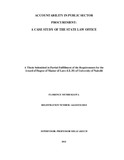| dc.description.abstract | The project looks into accountability in public sector procurement with the case study being the State Law Office. It has examined how procurement in the public sector has been abused, the reasons for the same and ways of promoting accountability and transparency.
Chapter one looks into the concept of accountability in public sector procurement and contextualizes procurement at the State Law Office. Eventually the importance of procurement in a bid to save the Government from losing funds has been critically examined by employing the principles of sound procurement namely competition, publicity, transparency and market criteria.
Chapter two addresses the continuous quest for accountability in public sector procurement considering its contribution to our country’s GDP. Integrity in the administration and promotion of a sound procurement system will be advocated. Assessment pillars of public procurement namely the legislative and regulatory framework, institutional framework and management capacity, procurement functions and market performances, integrity and transparency of the procurement system will be examined critically.
The world best practices have been considered so as to serve as a bench mark. The Model Law on procurement (UNCITRAL) has been taken as the point of reference coupled with the existing laws and regulations. Guidelines on accountability such as having a clear chain of command tied with effective control mechanisms, handling complaints in an equitable manner and subjecting public procurement to public scrutiny have been considered.
Chapter three has dealt with public procurement reforms in Kenya. It has addressed the historical background of procurement from the colonial times through the 1970s.It has considered the numerous tender boards that existed which are the Central Tender Boards(CTBs) for procurements above 2 million Kshs, Ministerial Tender Boards(MTBs) for procurements below 2 million Kshs and District Tender Boards for procurements at lower government levels. A number of financial regulations were put in place to guide procurement. Procurement law after the year 2001 has been looked into which was characterized by a unification of all financial circulars; by the establishment of the Exchequer and Audit (Public Procurement) Regulations. The Public Procurement Directorate (PPD) to regulate procurement operations and appeals and review bodies which were established have been examined.
In 2005, the Public Procurement and Disposal Act (PPDA) was enacted followed by the Public Procurement and Disposal Regulations (PPDR) of 2006. Bodies like the Public Procurement and Oversight Authority (PPOA), the Public Procurement Board and the Public Procurement Appeals and Review Board (PPARB) were established in a bid to promote accountability and transparency. Corruption and its effect on procurement has also been problematized.
Chapter four has addressed the practical aspect of procurement at the State Law Office, the organizational structure in connection to procurement, the problems or shortcomings and reform measures. Chapter five has concluded and recommended on the way forward. This is in a bid to promote accountability and transparency in the entire public sector procurement and more specifically at the State Law Office. | en_US |

